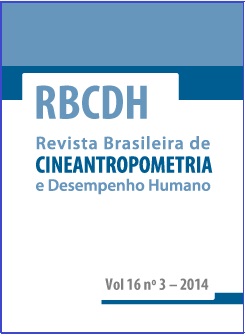Assimetrias na força muscular isométrica, taxa de desenvolvimento de força e na eficiência neuromuscular de extensores do joelho em diferentes faixas de idade
DOI:
https://doi.org/10.1590/1980-0037.2014v16n3p307Resumo
Neste estudo, avaliamos assimetrias na força, taxa de desenvolvimento de força (TDF) e eficiência neuromuscular de extensores de joelho em crianças, adultos e idosos. Cada sujeito realizou contrações isométricas voluntárias máximas e submáximas (15% e 30% da contração isométrica voluntária máxima). Força máxima, TDF e eficiência neuromuscular foram avaliadas e comparadas entre os grupos e entre perna preferida e não-preferida. Foram avaliadas crianças (média de idade de 8,4 ± 0,7 anos), adultos (média de idade de 23,2 ± 3,5 anos) e idosos (média de idade de 65,9 ± 7,0 anos), do sexo feminino. A TDF foi maior em adultos jovens, e similar entre crianças e idosos. A eficiência neuromuscular diminuiu significativamente com o envelhecimento (P<0,05). Foram observadas assimetrias em força e TDF em favor da perna preferida em idosos (P<0,05). Assimetrias em força e TDF em idosos podem ser justificadas por fatores neurais, como a mudança em favor do hemisfério cerebral direito, levando a assimetrias motoras. Este resultado sugere que tanto a avaliação física quanto o treinamento em idosos deve levar em consideração assimetrias, que parecem ser inerentes ao processo de envelhecimento. Assim, um protocolo simples para avaliar a força máxima e submáxima pode ser útil para quantificar déficits de força e potência em idosos
Downloads
Publicado
Edição
Seção
Licença

Direitos Autorais para artigos publicados nesta revista são do autor, com direitos de primeira publicação para a revista. Em virtude da aparecerem nesta revista de acesso público, os artigos são de uso gratuito, com atribuições próprias, em aplicações educacionais e não-comerciais, desde que seja dada a atribuição. Esta obra foi licenciada com uma Licença Creative Commons Atribuição 4.0 Internacional - CC BY


